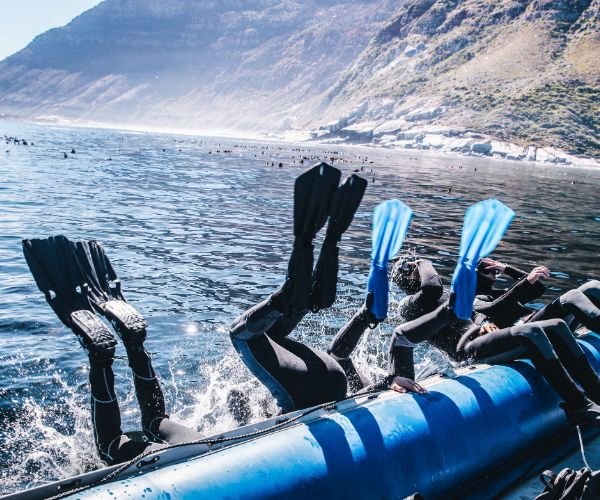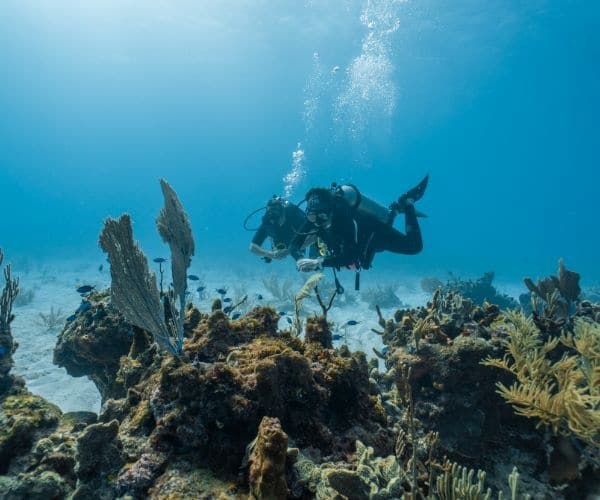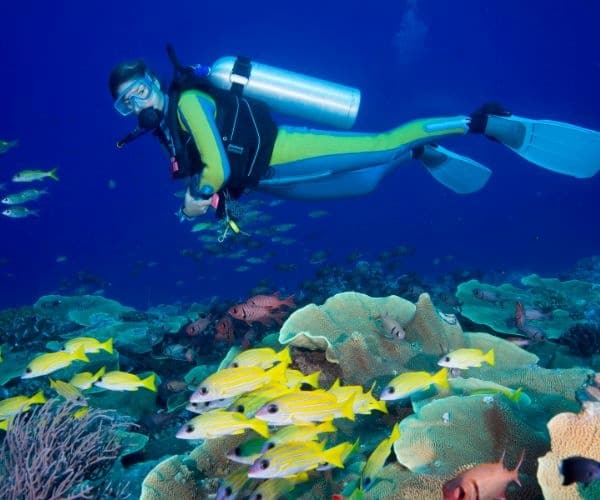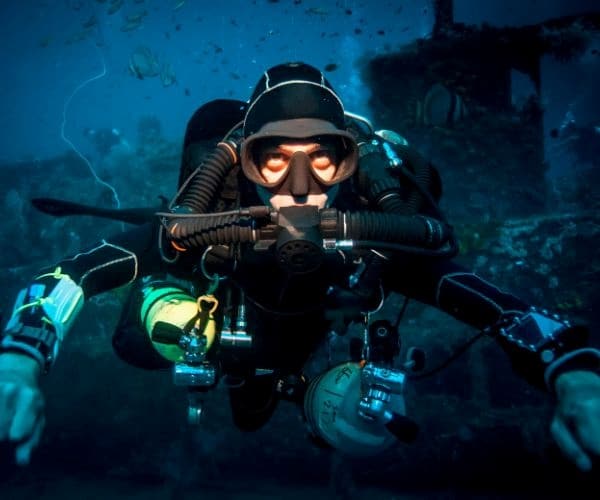Whether you’re just starting your scuba diving journey or planning your next dive trip, understanding the essential scuba diving equipment is key to a safe and enjoyable experience. From fins and masks to wetsuits and regulators, each piece plays a critical role. In this guide, we’ll walk you through the main gear you’ll need, what’s worth buying vs hiring, typical costs, and tips for transporting your equipment when you travel.
What equipment do you need for Scuba Diving?

Scuba diving gear falls into three main categories:
- Essential dive gear – required for safety and breathing underwater
- Exposure protection – for warmth and comfort
- Accessories – optional gear that can enhance your experience
Let’s explore each category in detail.
Scuba diving mask
Your diving mask allows you to see clearly underwater. It forms a watertight seal around your eyes and nose and is one of the most personal pieces of gear you’ll use.
- What to look for: Comfort, silicone skirt, wide field of view
- Cost: £30–£100
- Buy or hire? Buy. A well-fitting mask is essential and affordable. Plus, it’s more hygienic than hiring.
Top Tip: Anti-fog sprays can help keep your mask clear during dives.
Scuba diving fins
Fins allow you to move efficiently underwater with minimal effort. There are two main types: full-foot fins (used barefoot in warm water) and open-heel fins (used with boots in colder conditions).
- What to look for: Fit, blade stiffness, intended environment
- Cost: £40–£150
- Buy or hire? Buy or hire. If you’re diving regularly or have specific preferences, investing in a good pair makes sense.
Scuba diving suit (wetsuit or drysuit)
Your exposure suit protects you from cold, stings, and abrasions. Wetsuits are used in warm to temperate waters, while drysuits are best for cold-water diving.
- What to look for: Thickness (measured in mm), fit, zip placement, water temperature
- Cost: Wetsuits: £100–£300 Drysuits: £400–£1,200+
- Buy or hire? Depends. For regular or cold-water divers, buying a drysuit is a smart investment. For occasional warm-water dives, hiring a wetsuit is fine.
Top Tip: Layering a thermal vest under your wetsuit can extend your dive time in cooler waters.
Buoyancy Control Device (BCD)
The BCD helps you control your buoyancy underwater and keeps you afloat at the surface. It also holds your tank in place.
- What to look for: Fit, lift capacity, integrated weights, travel weight
- Cost: £250–£500+
- Buy or hire? Hire or buy. Hire if you dive infrequently; buy if you want a custom fit or lightweight model for travel.
Regulator
The regulator is the heart of your scuba setup, it delivers air from your tank to your mouth. It consists of a first stage (attached to the tank) and a second stage (your mouthpiece), plus alternate air sources.
- What to look for: Comfort, ease of breathing, cold-water rating
- Cost: £300–£700+
- Buy or hire? Hire or buy. Serious divers often invest in their own for hygiene and reliability.
Dive computer
A dive computer tracks your depth, time, and no-decompression limits, keeping you safe during your dive.
- What to look for: Clear display, intuitive interface, battery life
- Cost: £150–£800+
- Buy or hire? Buy. This is one of the most important safety devices you can own.
Weights and Tank
These are usually hired on-site. Carrying tanks and weights through airports is impractical.
- Cost: Typically included in dive centre packages
- Buy or hire? Hire.
What should you hire or buy?
Here’s a quick breakdown:
Equipment | Buy or Hire? |
Mask | Buy |
Fins | Buy or Hire |
Wetsuit | Buy or Hire |
Drysuit | Buy |
BCD | Buy or Hire |
Regulator | Buy or Hire |
Dive Computer | Buy |
Tank & Weights | Hire |
Scuba diving starter kit: the essentials
Not sure where to start? If you’re new to diving, focus on buying a few core pieces that are both affordable and high-impact for comfort and safety.
Recommended Beginner Gear:
- Mask – A good fit is key to avoid leaks and fogging.
- Snorkel – Optional, but handy for surface swims or training.
- Fins – Mid-range fins that suit your kick strength and dive conditions.
- Wetsuit (3mm–5mm) – Keeps you warm in most recreational dives.
- Mesh gear bag – Helps with rinsing and carrying gear efficiently.
Next steps: Once you’re confident and diving more regularly, consider investing in a dive computer, BCD, and regulator.
How to travel with scuba diving equipment

If you’re flying with your gear, weight and bulk are key concerns. Here are some tips for easier transport:
- Choose travel-friendly gear: Lightweight BCDs and regulators are designed for travel.
- Use a dive bag: Padded roller bags protect your equipment; backpack styles are great for island hopping.
- Pack smart: Carry delicate items like regulators and dive computers in your hand luggage.
- Rent bulky items: Tanks and weights are best left to the dive centre.
How to care for and maintain your scuba diving equipment

Investing in scuba gear means taking proper care of it. Well-maintained equipment lasts longer, performs better, and most importantly – keeps you safe underwater.
Cleaning after dives
- Rinse thoroughly with fresh water, especially after saltwater dives
- Pay special attention to zippers, hoses, and joints
- Let gear dry completely out of direct sunlight
Storage tips
- Store in a cool, dry area
- Hang wetsuits and drysuits on wide hangers
- Coil regulators loosely and store them in padded bags
Regular inspections
- Check O-rings, buckles, and inflation systems before each dive
- Annual servicing is recommended for BCDs and regulators
- Replace worn mouthpieces, straps, and clips as needed
What is the best scuba diving gear?
There’s no single “best” gear – it depends on your needs. But here are some top-rated brands for beginners and intermediates:
- Masks: TUSA Freedom HD, Scubapro Spectra
- Fins: Mares Avanti Quattro, Cressi Reaction Pro
- Wetsuits: Fourth Element, Scubapro Everflex
- BCD: Aqualung Rogue (great for travel), Mares Dragon
- Regulators: Apeks XTX50, Scubapro MK25
- Dive Computers: Suunto Zoop Novo, Shearwater Peregrine
Whenever possible, try before you buy – either through a dive shop or on a dive trip.
To round up…

Scuba diving is one of the most gear-intensive sports, but that doesn’t mean you need to buy everything at once. Start with a few essential items, learn how to care for them, and build your setup gradually. The right equipment makes diving safer, more enjoyable, and a lot more comfortable.
Whether you’re planning your first open water dive or looking to upgrade your kit, knowing your gear is half the journey. Dive smart, dive safe, and enjoy the underwater world!
Protect your scuba equipment with Scuba Diving Insurance from SportsCover Direct
Scuba diving is an exhilarating way to explore the world’s oceans, but it also comes with its share of risks and complexities. Whether you’re diving in tropical waters or venturing into deeper, more challenging environments, having the right insurance can provide essential protection and peace of mind.
At SportsCover Direct, we offer Scuba Diving Travel Insurance that’s built specifically for divers. Our coverage is designed to support you at every stage of your trip, with options that include worldwide protection, emergency medical cover, support for existing medical conditions, trip cancellations, and dives down to 40 metres or more.
Choose between single-trip or annual multi-trip policies tailored to your itinerary and level of experience. No matter where your next underwater adventure leads, you can dive with confidence knowing protected.
Find out more about our Scuba Diving Insurance and get a personalised quote today.
This blog has been created as general information and should not be taken as advice. Make sure you have the correct level of insurance for your requirements and always review policy documentation.